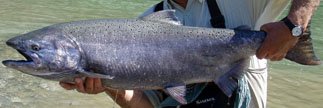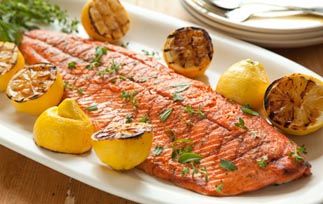Chinook salmon Nutrition facts
Chinook salmon is the most prized and largest of all the Pacific salmon species. No wonder it is named the "king of salmon" just for its size but also for its nutritious, omega-3, antioxidant-rich, delicious, moist, pinkish-orange flesh.
Scientific name: Oncorhynchus tshawytscha. It is the state fish of Alaska and Oregon.
The Chinook salmon has local names as blackmouth, king salmon, spring salmon, Masunosuke (マスノスケ), etc.
 |
| Chinook salmon. Photo: Sam Beebe |
Description
Chinook is anadromous fish that lives in the cold ocean waters of the North Pacific from the Monterey Bay area of California to the Chukchi Sea area of Alaska and on the Asian coast from the Anadyr River area of Siberia southward to Hokkaido, Japan.
Chinook is the largest of the five (Sockeye, Coho, Chum, and Pink) Pacific salmon species. Adults grow quickly in size. Chinook also has a black pigment along the gum line, thus the name "blackmouth" salmon.
Marine adult chinooks feature black, irregular spots on their back, which fade to silvery spots on the sides, and white on the belly. Another distinguishing feature is black and silver spots on the dorsal fins and tail fin.
Returning (spawning) male chinook in freshwater have characteristic copper to deep gray back. Females are typically gray. Adult males acquire a hooked upper jaw called a "kype" and a "ridged back."
Juveniles in freshwater (fry) are recognized by well-developed vertical parr marks on their back, extending beyond the lateral line on the sides.
Adult chinook weighs 15-45 lb, length 75-100 cm. Lifespan is about 3-7 years.
Biology
Chinook salmon are anadromous species similar to other Pacific salmon. They become sexually mature from their second through the seventh year, and as a result, fish in any spawning run may vary greatly in size.
In the summer, they travel from the ocean to upstream freshwater for spawning. Each female deposits between 3,000 and 14,000 eggs in several gravel nests, called redds. All chinook salmon die after spawning.
The fertilized eggs usually hatch in late winter and live in the gravel until the following spring when they grow as parr and subsequently migrate to the ocean as a smolt in their second year of life.
Adult chinook spend anywhere from 1-5 years feeding in the ocean and return to spawn in freshwater to complete the cycle.
Habitat
Chinook salmon are anadromous fish that live in saltwater as an adult but migrate into fresh water in the spring to spawn. They prefer cold (10-14 º C), well-oxygenated, clean waters to thrive.
Juveniles prey chiefly on zooplankton and insects. Adults in the ocean eat a variety of organisms, including herring, pilchard, squid, and crustaceans.
Harvesting
The harvesting season of Chinook salmon is allowed for 3-5 months only, from May through September.
They are harvested using a variety of gear types. In the freshwater, most of the salmon catch is done by trolling vessels with bait or lures through groups of feeding fish. Commercial ocean fisheries use purse seine nets to catch.
Health Benefits of Chinook salmon
Chinook salmon are most-sought after salmon varieties for their wholesome nutrition properties. 3.5 Oz (100 g) holds 179 calories.
American Heart Association recommends consumption of at least 2 servings of oily fish to fulfill requirements of essential fatty acids, protein, minerals, and fat-soluble vitamins.
The characteristic pink or orange-red color of chinook salmon flesh comes from the fat-soluble carotenoid pigment astaxanthin, that normally exists in crustacean meat like shrimp.
Astaxanthin is a biologically stable antioxidant, several hundred times more powerful than vitamin C and Co-enzyme Q10.
Chinook is a rich source of vitamin, D, and E and long-chain omega-3 fatty acids (PUFA).
Fresh chinook fillet is an excellent source of protein; 3.5 Oz of Chinook meat provides 19.93 g (36% of daily required levels). It is complete in the sense that it composes all the essential amino acids required for optimal growth and development.
Chinook fish is good source of omega-3 eicosapentaenoicacid (EPA), docosapantaenoicacid (DPA) and docosahexaenoic acid (DHA) fatty acids. Research studies suggest that these fatty acids, particularly DHA, play an important role in the development of neural systems, especially in infants and children.
In adults, several large trials have evaluated the effect of fish or fish oils on heart disease. In the "GISSI Prevention Trial, heart attack survivors who took a 1-gram capsule of omega-3 fats every day for three years were less likely to have a repeat heart attack, stroke, or die of sudden death than those who took a placebo".
It is one of the finest sources of some B-complex vitamins such as pyridoxine- 0.400 mg (31% RDI/100 g), niacin (vitamin B3: 53% RDI/100 g), and riboflavin.
Chinook filets compose 453 IU/3.5 Oz of Vitamin-A. vitamin-A and omega-3 are essential for healthy mucosa and skin.
100 g (3.5 Oz) of Chinook holds 526 IU of vitamin D; about 94% of daily recommended intake. Vitamin D plays an important role in the calcium metabolism and offers protection from cancers.
The Food and Drug Administration (FDA) recommends that pregnant women can eat at least 8 ounces and up to 12 ounces (340 grams) of a variety of seafood lower in methyl-mercury a week.
Furthermore, Chinook composes significant amounts of essential minerals like phosphorus, magnesium, and calcium. Selenium, iron, and iodine are some of the trace elements abundantly present in this fish.
| Principle | Nutrient Value | Percent of RDA |
|---|---|---|
| Energy | 179 Kcal | 9% |
| Carbohydrates | 0 g | 0% |
| Protein | 19.93 g | 36% |
| Total Fat | 10.43 g | 52% |
| Cholesterol | 51 mg | 17% |
| Dietary Fiber | 0 g | 0% |
| Vitamins | ||
| Folates | 30 μg | 7.5% |
| Niacin | 8.420 mg | 53% |
| Pyridoxine | 0.400 mg | 31% |
| Riboflavin | 0.113 mg | 19% |
| Thiamin | 0.054 mg | 4.5% |
| Vitamin-A | 453 IU | 15% |
| Vitamin-B12 | 1.3 μg | 6.5% |
| Vitamin-C | 4 mg | 6.5% |
| Vitamin-D | 526 IU | 131.5% |
| Vitamin-E | 1.22 mg | 7% | Electrolytes |
| Sodium | 47 mg | 3% |
| Potassium | 394 mg | 8% |
| Minerals | ||
| Calcium | 26 mg | 2.6% |
| Iron | 0.25 mg | 3% |
| Magnesium | 95 mg | 24% |
| Phosphorus | 289 mg | 41% |
| Zinc | 0.44 mg | 4% |
| Omega-3 fats (PUFA) | ||
| EPA (20:5 n-3) | 1.008 g | -- |
| DPA (22:5 n-3) | 0.301 g | -- |
| DHA (22:6 n-3) | 0.944 g | -- |
Buying
Wild-caught, as well as cage-farmed Chinook from New Zealand, is available in the U.S. stores. The Pacific salmon season lasts from May to September; if you see it outside of those months, it has been frozen, though it will still be delicious. Wild salmon is usually more expensive.
In the US, chinook is normally sold frozen whole or whole sides, filets, steak, and chunks. Smoked, salt-cured, and dried versions are also readily available. One can buy either whole or dressed into steaks and fillets.
Look for labeling on the package “farm-raised”/” wild-caught” and “responsible-harvested”/ “sustainable seafood.” If you buy whole fish, choose the one with bright, clear eyes, moist, shiny skin, firm consistency, and a fresh aroma.
Avoid the fish that smells pungent, fishy, or ammonia-like. Also, look for pink-orange flesh with clear white lines for the freshness of cut sections like steak.
Avoid smoked salmon with dried or brown edges that appear leaky and wet.Storage
Chinook salmon is fat and protein-rich fish. It attracts bacteria and quickly turns bad if not stored in the freezer sections soon after the harvest.
At home, store whole fish, fillets, steaks, and chunks in the refrigerator for use within 1-2 days, otherwise in the freezer section for extended use.
Food uses
Wild chinook from Alaskan waters is the most prized of all salmon species for its flavorful, omega-3-rich flesh and delicious taste.
It can be grilled, baked, steamed, roasted, or poached. The mid-portion flesh is more delicate than the flesh nearer the tail. If you prefer to skin, just peel it inside out. Remove any bones before cooking.
Just make sure, it should be cooked until the meat is opaque and flakes with a fork off easily.
Here are some serving ideas:
 |
| Chinook salmon-grilled. Credit: california king salmon |
Chinook salmon is enjoyed simply grilled in olive oil and herbs with a squeeze of lemon.
Relish crispy pan-sear filets or steaks in a butter-herb sauce for a couple of minutes, and serve with a lemon wedge as garnish.
Canned and smoked chinook used in sandwiches, salads, omelets, pasta dishes, mousses and casseroles, and quiches.
Masunosuke is the Japanese name for Chinook salmon. Salted salmon or shio-zake is a staple of the Japanese breakfast served with rice, miso soup, and pickles.
Japan largely imports wild-caught Alaskan and farmed New Zealand chinook to fulfill domestic demands. It is widely used in sushi and sashimi restaurants across Japan.
Chinook salmon roe (caviar) –is a larger grain salmon caviar (ikura) than other smaller salmon species. Both caviar (ikura) and roe in the sac (sujiko) are enjoyed as toppings in sushi and rice dishes in Japan.
Safety profile
Chinook have higher levels of mercury than other salmon, but these levels are still below those found in fish named in this advisory. Methyl mercury levels in Chinook salmon is 0.022 Parts Per Million (PPM).
Accordingly, the U.S FDA final guidelines on how much fish expectant as well as breastfeeding mothers can eat, along with lists of specific options that are safe or should be avoided, places chinook in the best choice category. By this yardstick, one can consume 2-3 servings a week. (Medical disclaimer).
Also read ≻≻-
≻≻- Mercury in Fish: Health Benefits, Risks, and Safe Choices
≻≻- Sockeye salmon nutrition facts and health benefits.
≻≻- Atlantic Cod nutrition facts and health benefits.
≻≻- Brook trout nutrition facts and health benefits.
≻≻- Halibut nutrition facts and health benefits.
≺≺ Back to Seafood from Chinook salmon nutrition facts and health benefits.
Further reading (Links opens in new window):
Chinook Salmon. PDF.
Omega-3 Fatty Acids: An Essential Contribution.